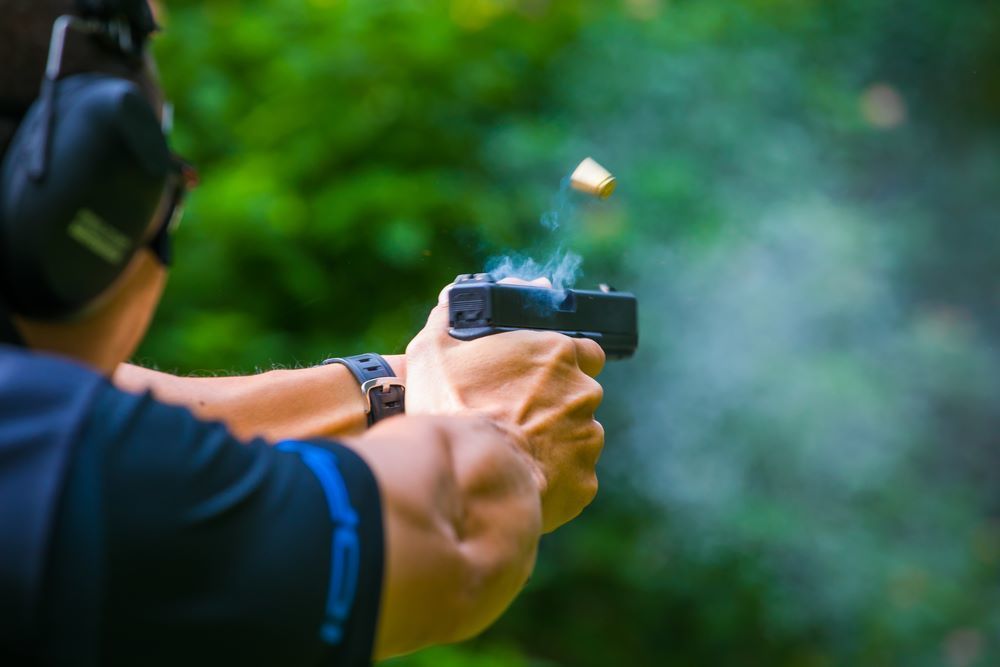As a hunter, one of the first things I needed to learn was how to shoot a pistol. You see it in movies and think it’s pretty easy, but you realize that it takes more time, effort, and experience to do so! From how to hold it down to what to prepare when shooting, you need to be prepared to avoid injury unto others and yourself.
With that said, how can you shoot a pistol properly? Read on as I show you a short and helpful guide on it now!
How to Shoot a Pistol
I’ll be tackling the different parts of shooting a gun to get you shooting safely, with stances your grip, and more tips!
1. Take The Eye Test
To help with your aim, consider what your dominant eye is. You can do this through the eye test, by putting your hands in front of you, making a diamond shape using your hands. Focus on one object in a distance, closing one eye than trying it with the other. Whichever eye is open when the object isn’t moving is the dominant eye.
2. What’s Your Stance?
You want to have the proper stance that isn’t only safe and accurate, but comfortable, too. There are five basic stances you can try doing and see where you feel most comfortable at:
- Weaver Stance is when your non-firing side is slightly advanced toward your target, and your firing arm slightly bent while the non-firing arm bent to help grip your pistol. The body should be a bit to the edge to your target then facing squarely.
- Champman Stance is similar to the Weaver Stance, though your shooting arm is fully extended. You’ll lockout the shooting elbow and lean your head to the side, resting on your hooting arm.
- Isosceles Stance has you facing squarely at the target and leaning forward. Your arms are fully extended and the elbows locked out, with your skeleton absorbing recoils.
- Retention Stance has you hold your pistol at waist-level from the side of the firing, with your arm bent slightly.
- Another bonus is the point stance, which is a one-handed firing position. It’s similar to the Retention Stance, with your non-firing hand balled up and held across your chest. You’ll be taking one step forward with your foot on the firing side, then extending the firing shoulder. Your arm and hand should be towards the target and made best for those who are already advanced shooters, ready to handle a gun.
Read more: Why Is It Important to Choose the Right Bullet for Your Gun?
3. Get a Good Grip
Your grip determines your chances of you hitting the target, the way you control your pistol, and making follow-up shots.
Make sure you have a hard grip but don’t crush the grip, feeling natural around your hands, with the thumb down and out of its way. Wrap the non-firing hand around your firing hand from the pistol’s front. Tilt the supporting hand forward then your palm’s heel in the grip’s open space.
Avoid cupping your pistol from your non-firing hand. This won’t be able to absorb any recoil, making it harder for your firing hand to keep your grip and position steady.
4. Look Into the Sight
A pistol sight usually has three dots in one line, with two outside on the rear sight and one in the front. You have to bring these dots into line with your dominant eye, or with an open eye with your target centered right under the pistol’s front sight.
Always focus on the front sight, which should be both clear and sharp, with the target looking blurry. Once your pistol’s targeted and the sights are clear, then fire!
5. Staying In Control
Shooting pistols isn’t just a physical but mental activity which requires focus. You focus on your body, the gun, target, and the surroundings. It’s difficult to focus on different things in one go, so you’ll need to practice in keeping control.
The first thing to do is to control your breath and heartbeats, relaxing before firing. Slow your breathing, don’t hold it, and then you’ll get used to the consistency, which has you take the accurate shot!
Read more: How to Build a Shooting Range On Your Property? The Top Tips to Follow
6. Avoid Bad Habits and Stay Safe
Last but not least, make sure that you continue practicing until you’re able to shoot in the field. You can further advance to other techniques once you have your stance, grip, and control set.
Just make sure that you avoid bad habits such as leading back, pushing your gun to the sides, among other unsafe techniques. Also, use hearing protection and goggles to stay safe while you train!
Check out this informative guide on the basic shooting fundamentals for more information:
Wrapping It Up
Hopefully, my guide on how to shoot a pistol helped you out. I highly recommend that you continue the lessons with Training Courses at MN Firearms, but this is a healthy start to begin shooting well. So don’t wait any longer and begin your training and practicing now!
If you have any questions or want to share more advice on how to shoot a pistol accurately, then comment below. Your thoughts are much appreciated.

